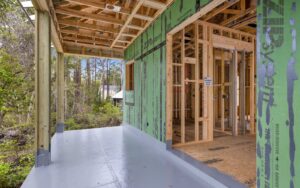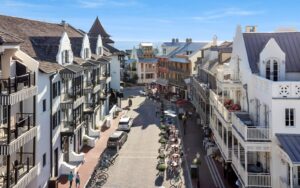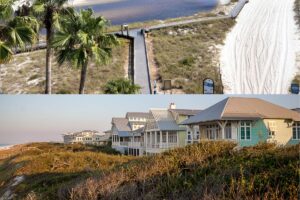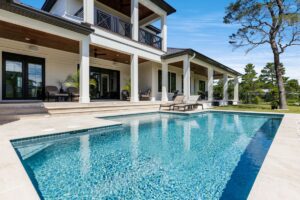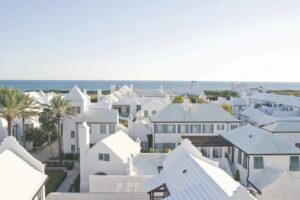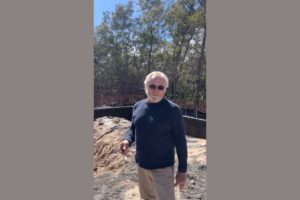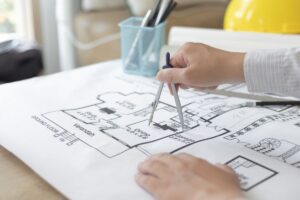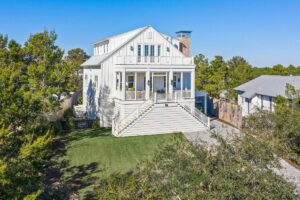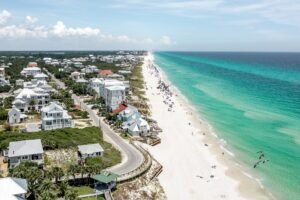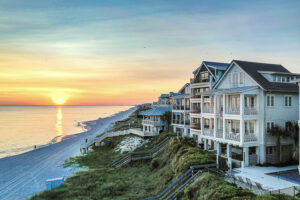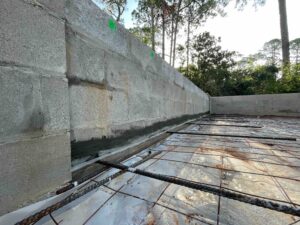A safe, healthy, comfortable, and durable house begins with a proper climate-specific foundation. Selecting the right foundation for your building site and intended purpose is crucial. Factors like geographical location, climate, soil conditions, and the structure’s intended use influence foundation choices. Health concerns and the structure’s expected longevity also play a role in determining the appropriate foundation type.
Common Foundations in the Panhandle
Raised Slab-on-Grade
- Description: A monolithic concrete slab where the footing and slab are poured simultaneously.
- Popularity: Most common and least expensive.
Raised Slab-on-Grade
- Description: Continuous footings with either concrete block or poured concrete steel-reinforced stem walls and a concrete slab.
- Popularity: Second most common, especially on slightly sloped sites (less than 4 feet).
- Cost Considerations: Reasonable, except near the coast due to deep and wide footing requirements.
- Structural Characteristics: Often built with reinforced block and/or poured concrete, creating a “fortress house.”
- Expense: Most expensive foundation and exterior wall system to construct.
Crawlspace
- Description: Continuous CMU or concrete stem-wall on a continuous footing with foundation vents and wood frame floor system.
- Caution: Not recommended in Florida due to moisture trapping under the floor system.
Walk-Out Basement
- Description: Rare in Florida due to flat terrain and high water table. Foundation slab is almost level with exterior grade on the lowest side of the slope.
Elevated Foundation Floor Systems
Wood Pilings
- Material: Pressure-treated round poles or square timbers.
- Usage: Supports a wood frame floor system. Third most common, used for flooding potential sites.
- Cost: Less expensive than prestressed concrete piles.
Prestressed Concrete Pilings
- Material: High-strength concrete and steel.
- Usage: Used with wood or concrete floor systems, common near beaches with tidal surges and flooding concerns.
- Cost: Most expensive piling foundation type.
Cylindrical Concrete Forms
- Material: Steel-reinforced, concrete-filled circular forms.
- Usage: Supports a wood frame floor system.
- Cost: Moderately priced.
Stacked Block Columns
- Material: Solid concrete-filled and steel-reinforced concrete masonry units (CMUs).
- Usage: Supports a wood floor system.
- Cost: Moderately priced.
Helical Piles/Piers
- Material: Square or round shafts driven into the ground with a rotating action, filled with concrete.
- Usage: Suitable for deep foundations, causing less soil disturbance and vibration than driving pilings.
- Cost: Less expensive than prestressed concrete and sometimes wood pilings.
Deep Foundation Options
Typically used under specific conditions like high wind zones, poor soil conditions, or areas prone to flooding and/or storm-driven tidal surges.
Foundation Recommendations
Architects, structural engineers, or geotechnical engineers (who conduct soil tests) usually recommend foundation types based on geographical location, owner’s preferences, and costs. Knowledgeable builders can also provide valuable input.
Foundation Requirements
All foundations must support the structure, prevent bulk moisture and vapor from entering the conditioned space, be airtight, and keep insects and critters out.
Construction Durability and Performance
Foundations must be built according to best building science practices for effectiveness.
Key Considerations
All foundations should consider geographical conditions (topography, seismic zone, building site location, orientation, soil conditions), climate conditions (cold, hot/dry, hot/humid, mixed climates, wind zone, annual rainfall, types of storms), and best practice construction.
Building Better Foundations
Intended Durability of Structure
- Requires climate-specific materials and construction methods.
- Knowledgeable builders understand best practices for long-lasting foundations.
Maintenance and Operating Costs
- Durable foundations reduce maintenance and operating costs, contributing to better indoor air quality and comfort.
Sustainability and Environmental Impact
- Durable construction is key for sustainability, requiring less maintenance over time.
Indoor Air Quality
- Control of air, heat, and moisture movement starts with the foundation, ensuring a safe, comfortable, and energy-efficient structure.
Building to Code vs. Building to Science
Selecting a foundation for your house in the North Florida Panhandle requires comprehensive knowledge of building science best practices. Grahame Family 30A Custom Home Builders knows how to construct these types of foundations and build houses that meet these criteria.
Contact Information
Give Kris a call at 850-220-1850 or email him at kris@gf30a.com. For face-to-face discussions, contact Kris or Tony at tony@gfh30a.com.
